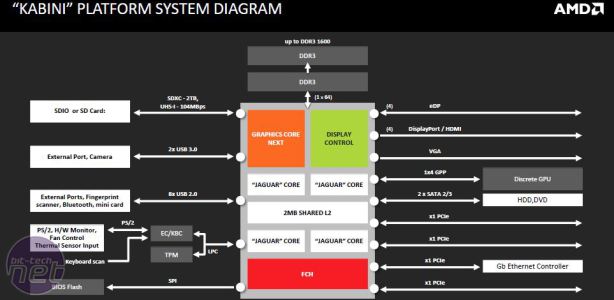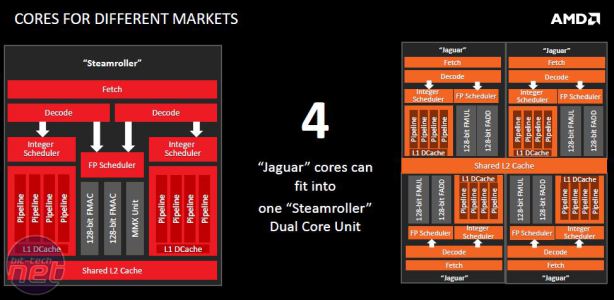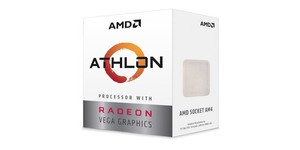
The first thing to note is that Socket AM1 is an entirely different beast to the current Socket FM2+, which plays host to Kaveri APUs. The Socket AM1 APUs are smaller but despite this, they represent AMD's first socketed SoC (system-on-chip), whereby the memory controller, GPU/display and I/O are all handled by the APU and not a motherboard-bound chipset or controller.
This means that motherboard costs can be kept to a minimum and seeing as we've seen plenty retailing for just £20, this is certainly proving to be the case. At launch, this provides two SATA 6Gbps ports, two USB 3 ports and eight USB 2 ports. There are also four PCI-E 2.0 lanes along with HDMI, DVI, DisplayPort and VGA, although our test board lacked DisplayPort and only supported six USB 2 ports, with only two of these actually built into the rear I/O panel.
Not only is there a memory speed limit that hits a wall at 1,600MHz, but Kabini is limited to single-channel as well. AMD's other APUs have traditionally benefited from fast memory to bring a boost to GPU performance - not so here. You're unable to select faster speeds in the BIOS too - something we confirmed by dropping in a 2,400MHz stick. Overclocking the GPU and CPU are also off-limits for the most part - we found we could increase the multiplier by 0.5x but with a baseclock of 100MHz, this is a drop in the ocean in performance terms and not even worth benchmarking.
We've heard rumours that the door might be open for motherboard manufacturers to add overclocking capability (faster memory support could be beneficial at the very least) but it's easy to see why this ability might not actually suit the platform - it's low cost and low power-orientated and if you start increasing the cost of motherboards, you're detracting from the whole point of Kabini in the first place. Despite this, all the boards we've seen so far offer dual DIMM slots, although we imagine most systems will end up with a single 4GB DIMM rather than two 2GB DIMMS for upgrade reasons.
Even so, with limited PCI-E lanes and cut-down memory performance, it's clear that, unlike Socket FM2+, Socket AM1 isn't aimed at Windows-based 3D desktop gaming or any kind of performance-heavy tasks, at least not without a discrete GPU. Also, unlike Kaveri, despite the 16x PCI-E slot making discrete GPUs an option, there's no AMD Dual Graphics support, although you're only ever able to pair up a fairly low-end GPU in any case.
The Athlon 5350 itself sports four Jaguar cores with a 2 compute unit GPU with a total of 128 GCN Radeon cores clocked at 600MHz. Its trio of siblings, the Athlon 5150 and the Sempron duo, offer ever reducing CPU and GPU clock speeds while the bottom end Sempron also takes a memory speed limit hit on the chin being limited to 1,333MHz. All have a TDP of 25W - a little more than your average Intel NUC but less than Intel's socketed desktop offerings, with AMD focusing more on Intel's embedded range.
Like the Steamroller core, Jaguar supports new instruction sets (BMI, AVX, FC16, SSE4.2, AES), is based on a 28nm manufacturing process and executes two integers (ALU) per cycle. However, unlike Steamroller, Jaguar has been designed for lower power, shares its L2 cache between all cores and uses 32KB versus 16KB L1 DCache per core. It's no secret that the likes of AMD's Bobcat-based E-350 embedded CPU lacked grunt, but with Jaguar, AMD is claiming a four-fold increase in Cinebench R15, doubling the single core speed test result too.
As far as cooling goes it's the first change to AMDs mounting mechanism for socketed CPUs in what seems like forever. Again, it's designed to cut costs and there are literally just two mounting holes - no mount itself, with the cooler needing to do all the work in terms of securing to the motherboard. With such a low TDP, there's clearly scope for fanless offerings too - the fan with our sample did prove to be quite noisy under load, so we'd be surprised if companies such as Akasa with its line of excellent mini-ITX and NUC fanless cases such as the Euler (see our review here) doesn't offer something for Socket AM1 soon.
This means that motherboard costs can be kept to a minimum and seeing as we've seen plenty retailing for just £20, this is certainly proving to be the case. At launch, this provides two SATA 6Gbps ports, two USB 3 ports and eight USB 2 ports. There are also four PCI-E 2.0 lanes along with HDMI, DVI, DisplayPort and VGA, although our test board lacked DisplayPort and only supported six USB 2 ports, with only two of these actually built into the rear I/O panel.
Click to enlarge
Not only is there a memory speed limit that hits a wall at 1,600MHz, but Kabini is limited to single-channel as well. AMD's other APUs have traditionally benefited from fast memory to bring a boost to GPU performance - not so here. You're unable to select faster speeds in the BIOS too - something we confirmed by dropping in a 2,400MHz stick. Overclocking the GPU and CPU are also off-limits for the most part - we found we could increase the multiplier by 0.5x but with a baseclock of 100MHz, this is a drop in the ocean in performance terms and not even worth benchmarking.
We've heard rumours that the door might be open for motherboard manufacturers to add overclocking capability (faster memory support could be beneficial at the very least) but it's easy to see why this ability might not actually suit the platform - it's low cost and low power-orientated and if you start increasing the cost of motherboards, you're detracting from the whole point of Kabini in the first place. Despite this, all the boards we've seen so far offer dual DIMM slots, although we imagine most systems will end up with a single 4GB DIMM rather than two 2GB DIMMS for upgrade reasons.
Even so, with limited PCI-E lanes and cut-down memory performance, it's clear that, unlike Socket FM2+, Socket AM1 isn't aimed at Windows-based 3D desktop gaming or any kind of performance-heavy tasks, at least not without a discrete GPU. Also, unlike Kaveri, despite the 16x PCI-E slot making discrete GPUs an option, there's no AMD Dual Graphics support, although you're only ever able to pair up a fairly low-end GPU in any case.
Click to enlarge
The Athlon 5350 itself sports four Jaguar cores with a 2 compute unit GPU with a total of 128 GCN Radeon cores clocked at 600MHz. Its trio of siblings, the Athlon 5150 and the Sempron duo, offer ever reducing CPU and GPU clock speeds while the bottom end Sempron also takes a memory speed limit hit on the chin being limited to 1,333MHz. All have a TDP of 25W - a little more than your average Intel NUC but less than Intel's socketed desktop offerings, with AMD focusing more on Intel's embedded range.
Like the Steamroller core, Jaguar supports new instruction sets (BMI, AVX, FC16, SSE4.2, AES), is based on a 28nm manufacturing process and executes two integers (ALU) per cycle. However, unlike Steamroller, Jaguar has been designed for lower power, shares its L2 cache between all cores and uses 32KB versus 16KB L1 DCache per core. It's no secret that the likes of AMD's Bobcat-based E-350 embedded CPU lacked grunt, but with Jaguar, AMD is claiming a four-fold increase in Cinebench R15, doubling the single core speed test result too.
On the second image - the far right APU is Kabini, on the left is a typical-sized AMD APU, in this case an FM1 A8-3850K
As far as cooling goes it's the first change to AMDs mounting mechanism for socketed CPUs in what seems like forever. Again, it's designed to cut costs and there are literally just two mounting holes - no mount itself, with the cooler needing to do all the work in terms of securing to the motherboard. With such a low TDP, there's clearly scope for fanless offerings too - the fan with our sample did prove to be quite noisy under load, so we'd be surprised if companies such as Akasa with its line of excellent mini-ITX and NUC fanless cases such as the Euler (see our review here) doesn't offer something for Socket AM1 soon.

MSI MPG Velox 100R Chassis Review
October 14 2021 | 15:04












Want to comment? Please log in.